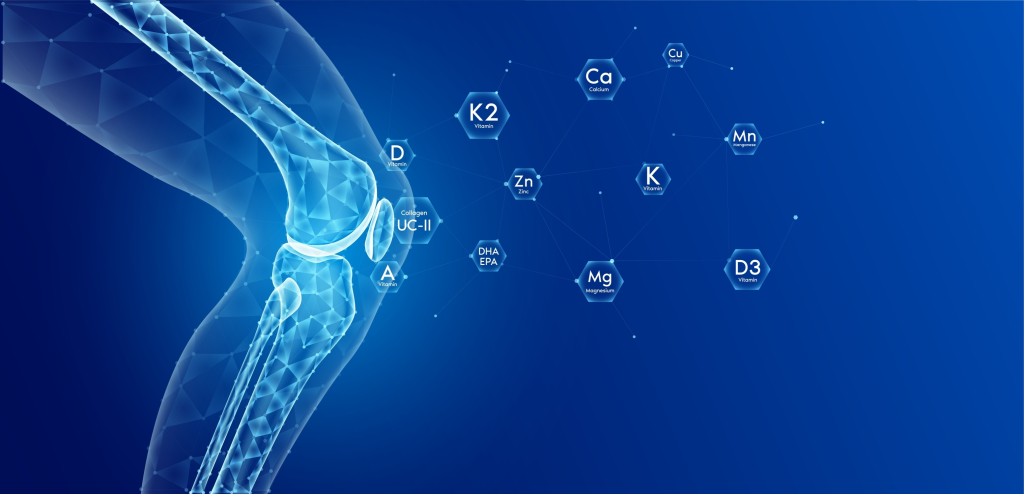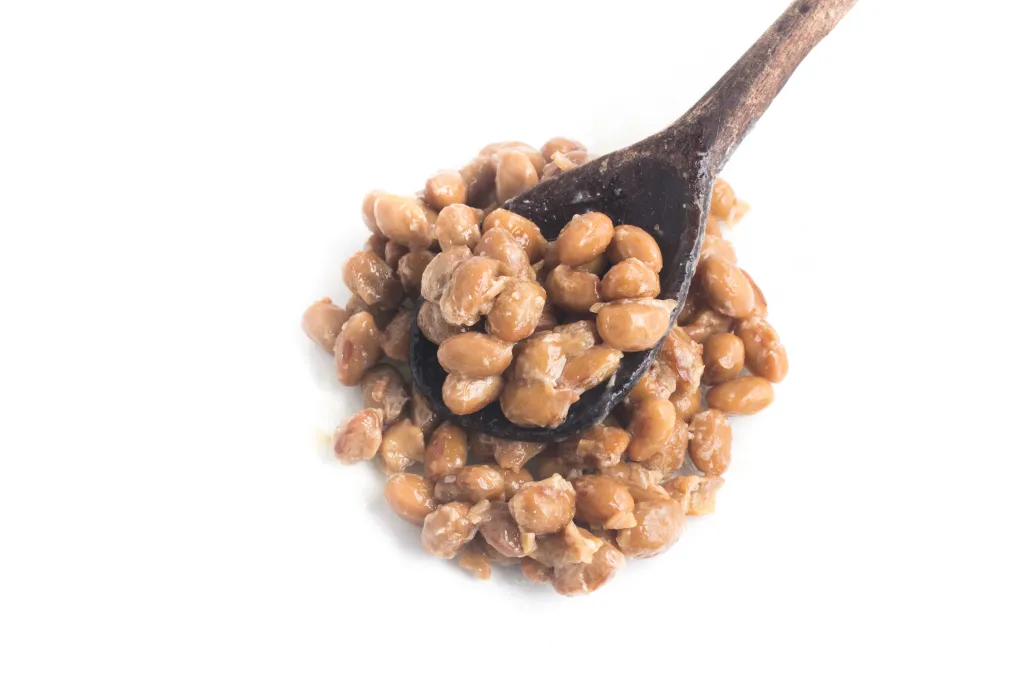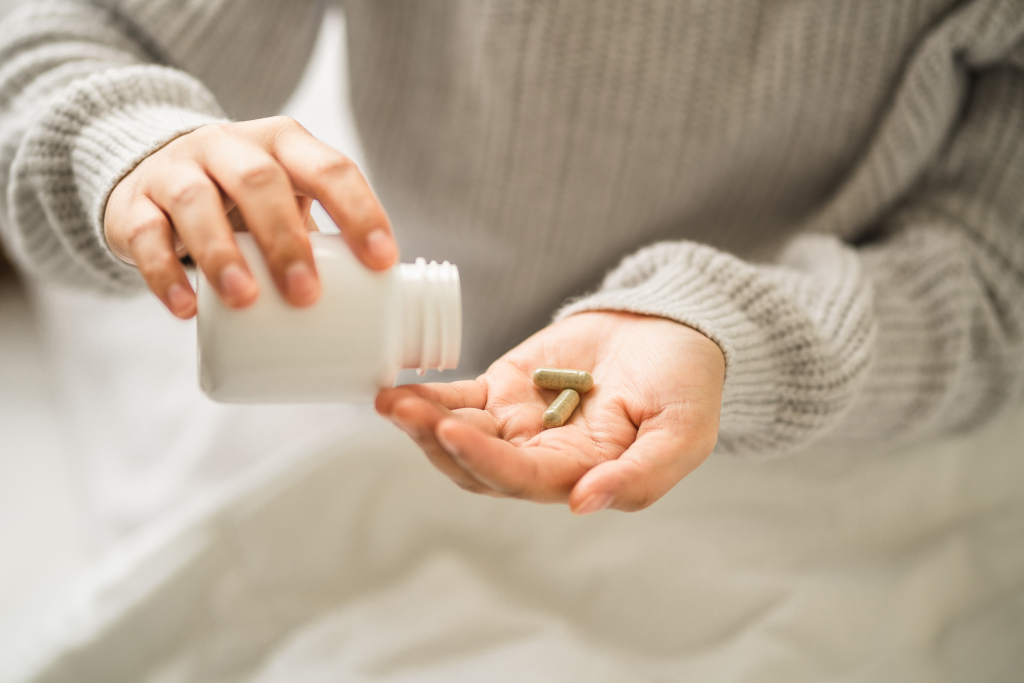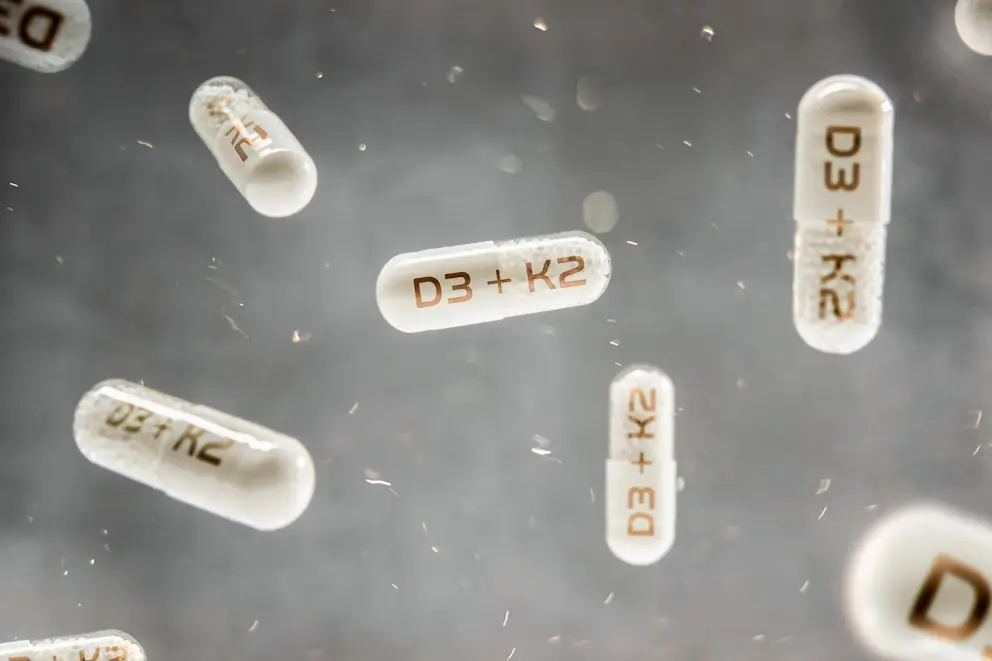Vitamin D3 and vitamin K2 are essential vitamins that work in combination to regulate calcium levels, promote bone health, and support cardiovascular wellness.
Discover three vitamin D3 and K2 benefits and learn why you should ensure your vitamin D3 and K2 levels are balanced.
What is vitamin D3?
Vitamin D, also known as the sunshine vitamin, is produced when ultraviolet B (UVB) radiation from sunlight exposure penetrates the skin and stimulates the biochemical conversion of pre-vitamin D into active vitamin D3.
Vitamin D3 is primarily stored in fat cells and the liver and is needed to regulate a wide range of physiological functions.
This fat-soluble vitamin supports calcium absorption in the small intestines, which promotes bone health and supports healthy bone structure throughout life.
In addition, vitamin D influences cognitive and neurological functions and may support healthy mood balance due to its ability to help regulate neurotransmitters such as serotonin, which is associated with mood and stress response.
Vitamin D deficiency is common, and it’s believed that almost half of all U.S. adults are at risk of low vitamin D levels.
“Symptoms of low vitamin D stores can be non-specific and subtle, making it hard to diagnose vitamin D deficiency early,” explains Dr. Berg.
Here are common signs of vitamin D deficiency:
- Low energy and weakness
- Bone discomfort
- Muscle aches
- Low mood
- Weakened immune function
- Skin problems
- Hair loss
- Poor focus
Watch the video below to discover the health benefits and sources of vitamin K2.
What is vitamin K2?
Vitamin K2 is a fat-soluble vitamin that plays an important role in supporting normal blood clotting, calcium metabolism, and bone health.
Blood contains several vitamin K-dependent proteins, also known as matrix Gla protein (MGP), involved in the formation of blood clots, an important mechanism that helps regulate wound healing.
Low vitamin K status may impair the activation of MGPs, which can affect normal blood clotting processes.
Vitamin K also activates proteins in blood vessels that help deposit calcium into bone tissue. Not only does this help promote bone mineral density, a marker of healthy bones, but it also helps promote arterial flexibility and overall health.
Here are common signs of vitamin K deficiency:
- Bruising more easily than usual
- Slower healing of cuts or scrapes
- Gum sensitivity
- Heavier menstrual flow
Because of its role in blood clotting and calcium balance, maintaining healthy levels of vitamin K2 while pregnant has been found to support fetal bone growth and may help promote normal blood function during childbirth.

How do vitamin D3 and K2 work together?
Vitamin D3 and K2 work together to support the body’s calcium balance.
While vitamin D3 helps the body absorb calcium from food, vitamin K2 complements this by helping deposit calcium in areas where it’s needed, such as bones and teeth.
Without vitamins D3 and K2, calcium levels in various tissues may become imbalanced, which can affect various critical functions and processes throughout the body.
This explains why maintaining a balance between vitamin D3 and K2 levels is essential to supporting bone strength, circulatory health, and overall wellness.

Three benefits of vitamin D3 and K2
Vitamin D3 and vitamin K2 are two fat-soluble vitamins that work together to support the body’s calcium regulation. When properly balanced, these two nutrients offer complementary benefits for bone strength, cardiovascular system function, and skin health.
Here are three benefits of vitamin D3 and K2.
1. Support heart health
Maintaining balanced levels of vitamin D3 and K2 is important for circulatory health and may help promote longevity and healthy aging.
A study published in BMJ Open investigated the link between vitamin D3, vitamin K2, and heart health and found that adequate vitamin K and D status is associated with better cardiovascular outcomes.1
2. Promote bone integrity
Vitamin D3 and K2 are necessary to ensure adequate calcium deposition into the bone matrix, which contributes to skeletal strength and structure.
Taking vitamin D3 and K2 in the right proportion can support healthy bone mineralization and may help maintain bone health throughout life.
3. Supports healthy skin
Vitamin D3 supports immune balance, collagen production, and skin cell turnover, while K2 contributes to vascular flexibility and may assist in preserving collagen structure.
Together, vitamins D3 and K2 can help promote smooth, resilient skin and support healthy circulation, which can contribute to skin elasticity and an even complexion.

What’s the best vitamin D3 and K2 dosage?
The best vitamin D3 and K2 dosage depends on several factors, including your health status, age, and your existing vitamin D and K levels.
While the National Institutes of Health (NIH) suggests adults get 600 international units (IU) of vitamin D3 daily, some individuals may need much higher amounts of around 10,000 IU to help maintain optimal blood levels, especially if they spend little time in the sun or have low dietary intake.2
While general vitamin K2 intake recommendations range from 120 micrograms (mcg) daily for men to 90 mcg daily for women, the ideal vitamin K2 dosage depends on how much vitamin D3 you take.
The best ratio of vitamin D3 and K2 is 1000:10, which means you should take 10 mcg of vitamin K2 per 1000 IU of vitamin D3.
Since getting the correct dosages of vitamin D3 and K2 can be tricky when taken separately, it’s best to choose a combined supplement with a 1000:10 D3 to K2 ratio to ensure balanced intake and support overall health.

Best sources of vitamin D3
The most natural and effective way to produce vitamin D3 is through direct sun exposure, which provides UVB rays that stimulate vitamin D synthesis in the body.
Just 10 to 15 minutes of sun exposure on the arms and face during peak hours may generate thousands of IU of vitamin D.
However, many factors, such as limited sunlight, time spent indoors, darker skin tone, metabolic health, age, and geographic location, can significantly reduce the body’s ability to make enough vitamin D3 from sunlight alone.
Vitamin D3 is also found in small amounts in certain foods, including cod liver oil, fatty fish like salmon and sardines, as well as egg yolks, and organ meats.
Although certain foods do contain vitamin D, they usually supply less than 20% of the recommended daily amount.
Due to this limited availability from diet alone, supplementation is often a more reliable and consistent way to support vitamin D3 intake.

Best sources of vitamin K2
Vitamin K naturally occurs in two forms: vitamin K1 and K2.
Vitamin K1 is primarily found in plant-based foods, particularly green leafy vegetables and certain vegetable oils.
Vitamin K2 can be obtained from animal products and fermented foods, and can also be produced by certain gut bacteria.
It’s thought that vitamin K2 is more effective than vitamin K1 and has a longer half-life in the body, meaning it remains in the bloodstream for extended periods.
Here are some of the best vitamin K2 sources:
- Natto
- Sauerkraut
- Grass-fed beef
- Pasture-raised eggs
- Full-fat dairy products

Vitamin D3 and K2 supplements
While most vitamin D supplements contain D3, some low-quality dietary supplements are made with D2, also called ergocalciferol. This less-effective form of vitamin D is linked to a higher risk of gastrointestinal side effects and should be avoided.
It’s also important to choose a balanced vitamin D3 and K2 supplement that offers a D3 to K2 ratio of around 1000 IU D3 for every 10 mcg of K2.
Although both vitamin D and K are generally well tolerated, it’s important to note the potential risks of taking excessive doses of D3 and K2.
The National Kidney Foundation warns that too much vitamin K2 may pose risks for individuals with kidney failure.3
Vitamin K influences blood clotting and shouldn’t be taken with blood-thinning medications such as warfarin or by individuals with bleeding disorders.
In addition, excessive vitamin D intake, particularly without enough K2, can lead to vitamin D toxicity, a rare but serious condition that can have serious health consequences, including dangerously elevated calcium levels.
To minimize the risk of side effects and potential drug interactions, it’s crucial to consult a healthcare provider before adding vitamin D3 and K2 supplementation to your routine.

Key takeaways
Vitamin D3 and K2 work together to support calcium balance, bone strength, vascular flexibility, cardiovascular wellness, and healthy skin.
Vitamin D3 increases calcium absorption, while vitamin K2 helps direct calcium into bones and teeth, which promotes structural integrity and circulatory health.
To maximize vitamin D3 and K2 benefits, it’s crucial to choose a vitamin D3 supplement that contains a vitamin D3 to K2 ratio of at least 1000:10, meaning it delivers 10 mcg of vitamin K2 for each 1000 IU of vitamin D3.
FAQ
1. What is vitamin K2?
Vitamin K is a fat-soluble vitamin that supports normal blood clotting and helps regulate calcium placement in the body.
2. Why should I take vitamin D3 and vitamin K2 together?
Together, vitamins D3 and K2 support healthy calcium balance. Vitamin D promotes intestinal calcium absorption, while vitamin K2 helps direct calcium into bones and teeth.
3. How much vitamin D3 and K2 do I need each day?
Vitamin D3 requirements can range between 600 and 10,000 international units (IU) daily, depending on vitamin D status, average sun exposure, and skin tone.
Most healthcare providers recommend a daily vitamin K intake of 120 micrograms (mcg) for men and 90 mcg for women. K2 should always be consumed in a balanced ratio with vitamin D3 of 10:1000, meaning 10 mcg of vitamin K2 for each 1000 IU of vitamin D3.
4. What are the top vitamin D3 + K2 benefits?
Combining vitamin D3 and K2 benefits skeletal and brain health, calcium balance, and circulatory wellness. This nutrient combination may also support metabolic and reproductive health.
5. Should I take vitamin D3 and K2 daily?
It’s generally recommended to take vitamin D3 and K2 daily to support optimal calcium metabolism and bone health.
6. Who should not take vitamin D3 and K2?
Those with kidney conditions, bleeding disorders, or individuals taking medications, such as anti-seizure drugs, diuretics, and blood thinners, should speak with a healthcare provider before incorporating vitamin D3 or K2.
7. Should I take vitamin D3 and K2 in the morning or at night?
Most people take vitamin D3 and K2 in the morning or at lunchtime with a fat-containing meal to enhance the absorption of these two fat-soluble vitamins.
However, vitamin D can promote healthy sleep, and people with sleep issues may benefit from taking vitamin D3 and K2 before bedtime.
8. How can I get vitamin K2 naturally?
Vitamin K2 is naturally found in fermented foods such as natto and sauerkraut, as well as animal products, including grass-fed beef, pasture-raised chicken eggs, and dairy products.
9. Are vitamin D3 and K2 supplements safe?
Yes, vitamin D3 and K2 supplements are generally considered safe and well-tolerated when taken in appropriate doses.
10. What are the symptoms of vitamin D and vitamin K deficiency?
Vitamin D deficiency symptoms may include low energy, mood imbalance, poor immunity, and musculoskeletal discomfort. Low vitamin K intake might lead to frequent bruising, gum sensitivity, or a heavier-than-usual menstrual flow.
11. Can you get vitamin D3 and vitamin K2 from food?
Dietary sources of vitamin D3 include egg yolks, organ meats, fatty fish, and cod liver oils. However, these foods contain only small amounts and won’t be enough to maintain a healthy vitamin D status through diet alone.
Vitamin K2 can be found in grass-fed beef, chicken eggs, dairy products, and fermented foods such as sauerkraut and natto, a Japanese soybean dish.
12. Does vitamin K2 interact with any medications?
Vitamin K2 can interact with blood-thinning medications such as warfarin and certain antiplatelet drugs.
13. What is the best ratio of vitamin D3 to K2?
The best ratio of vitamin D3 to K2 is 1000:10, which means a balanced vitamin D3 and K2 supplement should contain at least 10 mcg of vitamin K2 per 1000 IU of vitamin D3.







